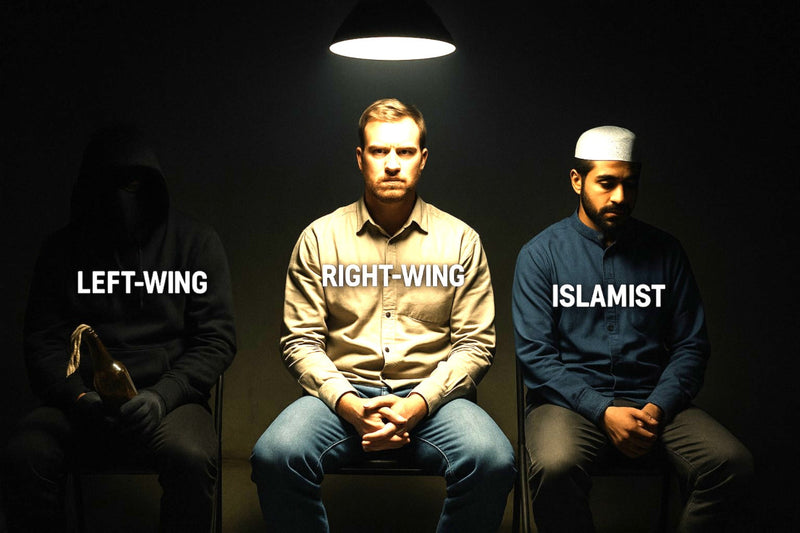
Subjects of Interest:
American Military University (AMU)
Introduction to Homeland Security and Defense
The Introduction to Homeland Security and Defense course at AMU is designed to cover national security concepts, homeland defense strategy, risk management, and civil liberties. While the course appears neutral at first glance, the class reading assignments reveal ideological bias. The curriculum disproportionately emphasizes right-wing and white supremacist threats as the primary domestic danger while minimizing or omitting left-wing and Islamic extremism in domestic contexts. This analysis shows how that bias appears across key topics.
The course material consistently focuses on technical models like all-hazards approaches, critical infrastructure protection, and risk management formulas. These sections remain neutral. They describe how systems should be protected from a range of threats, including natural disasters, cyberattacks, and technological failures, without prioritizing any ideological group. The technical focus avoids domestic ideological threat narratives entirely.
The bias emerges when the course addresses ideological threats. The reading material highlights right-wing extremism, especially white supremacist violence, as the most lethal domestic terrorism threat. Islamic extremism is treated as the primary foreign or foreign-inspired threat, but not as a major domestic concern despite its historical impact. Left-wing extremism is almost invisible in the curriculum. This selective focus is reinforced by how investigative resources are allocated. The curriculum shows that government attention on right-wing groups produces more data, arrests, and cases involving them. This creates the perception that right-wing extremism is the greatest domestic danger. In contrast, little effort is made to investigate left-wing groups, leaving their activity underreported.
The course highlights intelligence failures that allowed 9/11 to happen and the structural reforms that followed. It shows how surveillance tools expanded to counter Islamic terrorism, but these tools were later seen as ineffective at stopping domestic right-wing violence. The curriculum acknowledges civil liberties concerns but focuses more on technical surveillance capabilities than on balanced threat scrutiny.
When covering homeland defense, border security, and the role of the Department of Defense, the course material stays neutral. It prioritizes external threats from nation-states like Russia, China, and Iran, and discusses military support to civil authorities without ideological bias. Domestic extremism isn’t part of this topic’s focus.
The selective focus of the course also surfaced in student discussions. In my Week 3 online forum, I noted that the curriculum, like broader institutions, downplays left-wing violence despite its visible impact, while focusing heavily on right-wing threats. I argued that law enforcement and government agencies allocate disproportionate resources to right-wing groups, which generates more arrests and data and reinforces the perception that these groups are the primary domestic danger. Meanwhile, left-wing violence remains underreported because it isn’t investigated or scrutinized at the same level. And when they’re arrested, they’re rarely prosecuted. This exchange highlighted how the course environment reflects and reinforces the ideological imbalance seen in the class reading material.
My Week 4 discussion post reflected how the course’s technical topics allowed for neutral, fact-based engagement. I focused on critical infrastructure risk management, the energy sector, and the importance of resilience planning and public-private collaboration. This experience reinforced that much of the course’s technical content avoided ideological bias and encouraged constructive analysis without political spin.
My Week 8 discussion post focused on civil liberties, the PATRIOT Act, and surveillance. I argued that while these tools were created to protect national security, they’re applied unevenly. Left-wing groups often face less scrutiny, while right-wing groups are more aggressively targeted. This creates a perception of bias in enforcement that matches the imbalance found in the curriculum, and AMU’s pattern of bias against the right.
My midterm paper focused on the threat of left-wing violence and its near-total absence in the course content. I argued that left-wing extremism has caused significant damage to the homeland, yet the curriculum downplays or ignores it while highlighting right-wing threats at every opportunity. My final paper on fusion centers further illustrated how political priorities distort homeland security practice. I showed how these fusion centers, instead of providing unbiased intelligence, disproportionately target right-wing groups and overlook left-wing threats, creating a feedback loop of bias that is reflected in the course material. These assignments demonstrate that my critique of ideological imbalance wasn’t limited to casual discussion, but was a consistent, documented part of my academic work during the class.
The course highlights right-wing extremism as the major domestic threat, minimizes left-wing violence, and fails to integrate Islamic extremism consistently into domestic threat analysis. Technical areas of the curriculum stay neutral, but ideological bias is clear when domestic threats are covered. A fair course would apply consistent scrutiny to all forms of extremism.
Click the links below for a breakdown of AMU’s counter-terrorism and homeland security curriculum. Each entry focuses on a specific course, pattern, or policy, exposing how bias undermines national security and professional training.
Why did you create Misleading by Design?
As a writer, I’ve experienced the joy of creating stories but also the frustration of navigating the publishing world. Behind the scenes, the process of marketing a book is filled with scams, schemes, and people looking to take advantage of authors. With over 30 years of experience in intelligence and investigations, I realized I could use those skills along with my writing background to help expose the bad actors in our industry and beyond. Misleading by Design is my way of fighting back.
Your projects seem all over the place. Why not just stick to one subject or theme?
At first glance, my projects might seem scattered. I write about ghost stories, spiritual preservation, investigative reporting, and even political analysis. But they all serve one purpose. Each one invites readers to interpret what they see based on their own beliefs, experiences, and instincts. That's the heart of Branching Plot Books. Whether it's a scroll sealed with a forgotten soul, a book that can be read multiple ways, or a report that exposes something hidden in plain sight, the goal is the same. I want readers to take an active role, to question the surface, and decide what they believe is real. The stories may differ, but the purpose is always connected.
What is Misleading by Design’s Briefing Room?
It’s an investigative blog that exposes political bias, fraud, scams, and manipulation in institutions that claim to educate or protect the public. That includes universities, publishing platforms, corporate programs, and anything else hiding an agenda behind a professional front.
Who runs this blog?
I do. Arthur Mills. I’m a retired U.S. Army Chief Warrant Officer 3 and former All-Source Intelligence Technician with 31 years of experience in intelligence and investigations. I’ve tracked extremist threats, exposed political corruption, and led intelligence operations. I’ve seen what real indoctrination looks like, and I’m calling it out when I see it again. This time in classrooms and consumer markets.
Are you affiliated with any political group?
No. I don’t work for any party, PAC, campaign, or media outlet. I’m not here to push an agenda or play politics. I’m here to expose whoever’s lying, misrepresenting, or manipulating others, regardless of which side they’re on.
When I worked in the private sector, I conducted opposition research and tracked domestic extremist groups from across the political spectrum. I’ve investigated threats from both the left and the right. I don’t excuse violence, bias, or propaganda just because it aligns with one side’s agenda. If you're hiding your motives behind credentials, credentials behind ideology, or ideology behind fake neutrality, you're part of the problem. And you’ll show up here.
Why are you investigating food? What does this have to do with Branching Plot Books?
Because it’s the most common scam nobody talks about. Fast food chains show thick burgers and crisp fries in their ads, then hand you a flattened mess in a greasy bag. Grocery stores use packaging that promises quality but delivers bland, shriveled, or half-empty products. It’s manipulation through presentation. They sell the illusion, not the item.
And that’s the same trick used in education, politics, publishing, and everywhere else. If they can sell you a lie in a sandwich, they can sell it anywhere.
Misleading by Design fits the larger mission of Branching Plot Books by turning real-world scams into something the reader has to question, interpret, and investigate. Like my other projects, it doesn’t hand you answers. It gives you evidence, patterns, and contradictions, then dares you to put the pieces together. Whether it’s testimonies from the lost souls, curriculum bias, staged food ads, or publishing cons, the goal is the same: to make you rethink what you’ve been told and see how easily truth gets packaged, sold, and distorted.
What made you investigate American Military University?
Because it claims to train intelligence and homeland security professionals. What it’s actually doing is grooming students to think one way, speak one way, and ignore anything that doesn’t fit the school's left-wing agenda. That isn’t education. That's political indoctrination.
When I was tracking domestic extremist groups, I kept asking the same question. Where does this hate come from? What feeds it? I suspected the root was in their education. What they were taught. What they were not taught. That includes schools and universities. The slogans change, but the indoctrination is baked in.
After retiring from the military, I decided to get the formal education to match my experience. I chose a degree in Counter-Terrorism from American Military University. It promotes itself as a leader in intelligence, counter-terrorism, and homeland defense. It’s one of the largest programs of its kind. On paper, it looked like the right fit.
It wasn’t.
Course after course, it became clear that AMU wasn’t teaching students how to counter terrorism. It was teaching them how to adopt one worldview. How to view one side as the enemy. How to justify violence and extremism from the other. This wasn’t counter-terrorism. It was a curriculum on how to become a left-wing extremist.
I document everything. The entire report is published on The Briefing Room, in serialized form. I sent it to professors and top university officials. They ignored it. They didn’t defend their curriculum. They didn’t ask for clarification. They ignored me. They know I’m on to them.
That's why I’m staying in the program. I’m not there for the degree anymore. I don’t need it. I’m there to finish the investigation. American Military University has built a propaganda machine. And I plan to expose every part of it.
Do you accept tips or leads?
Yes. If you’ve seen something worth investigating, send it through my contact page. I check everything personally.
This includes curriculum bias at any level, from elementary schools to universities. If you’ve seen political agendas being pushed in grade school lesson plans, high school classrooms, college syllabi, or university programs, I want to hear about it. If you’ve dealt with fake credentials, unethical hiring, publishing fraud, corporate indoctrination, or institutional censorship, send it in. I follow evidence, not agendas.
If something feels off and you think no one else will touch it, send it anyway. I’ll look into it.




0 comments